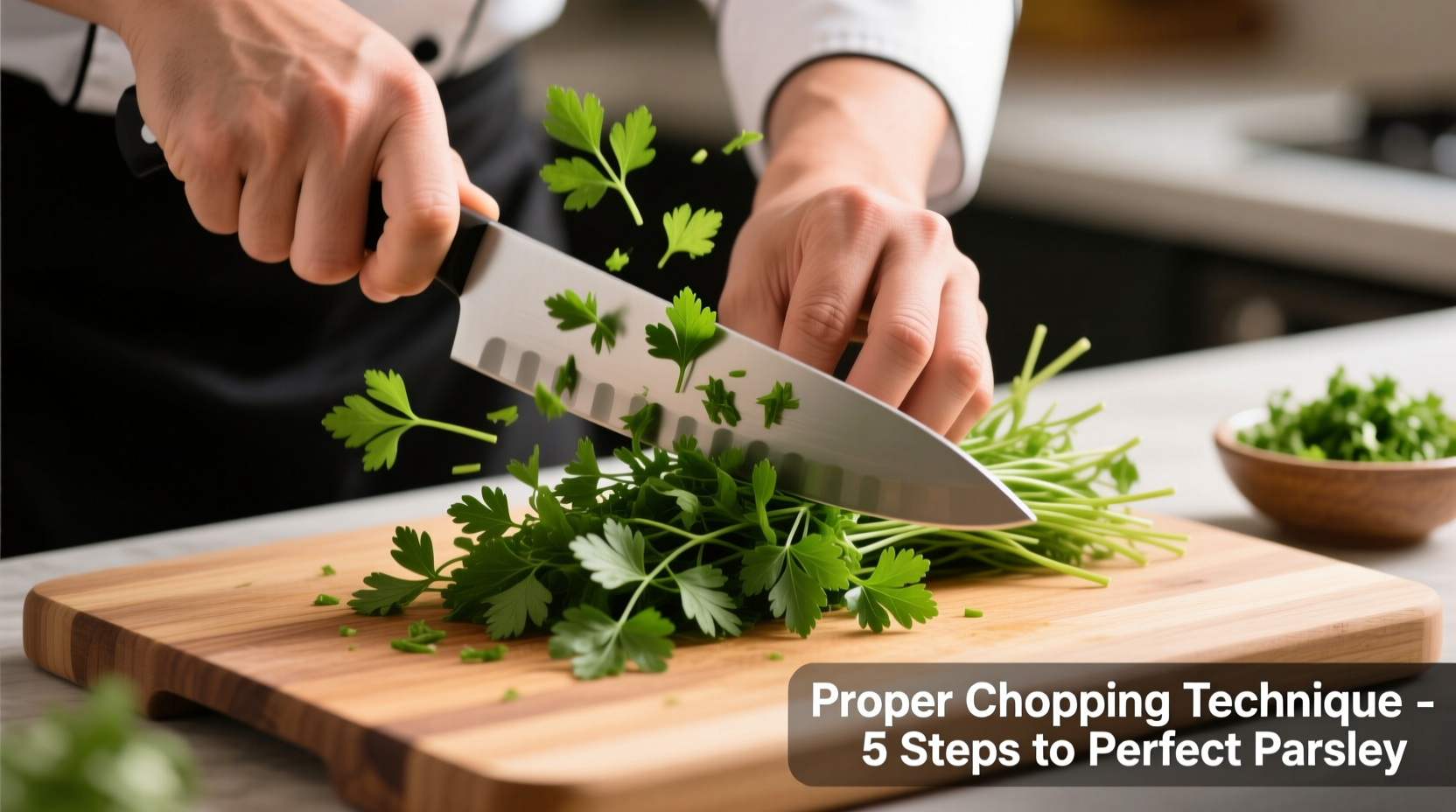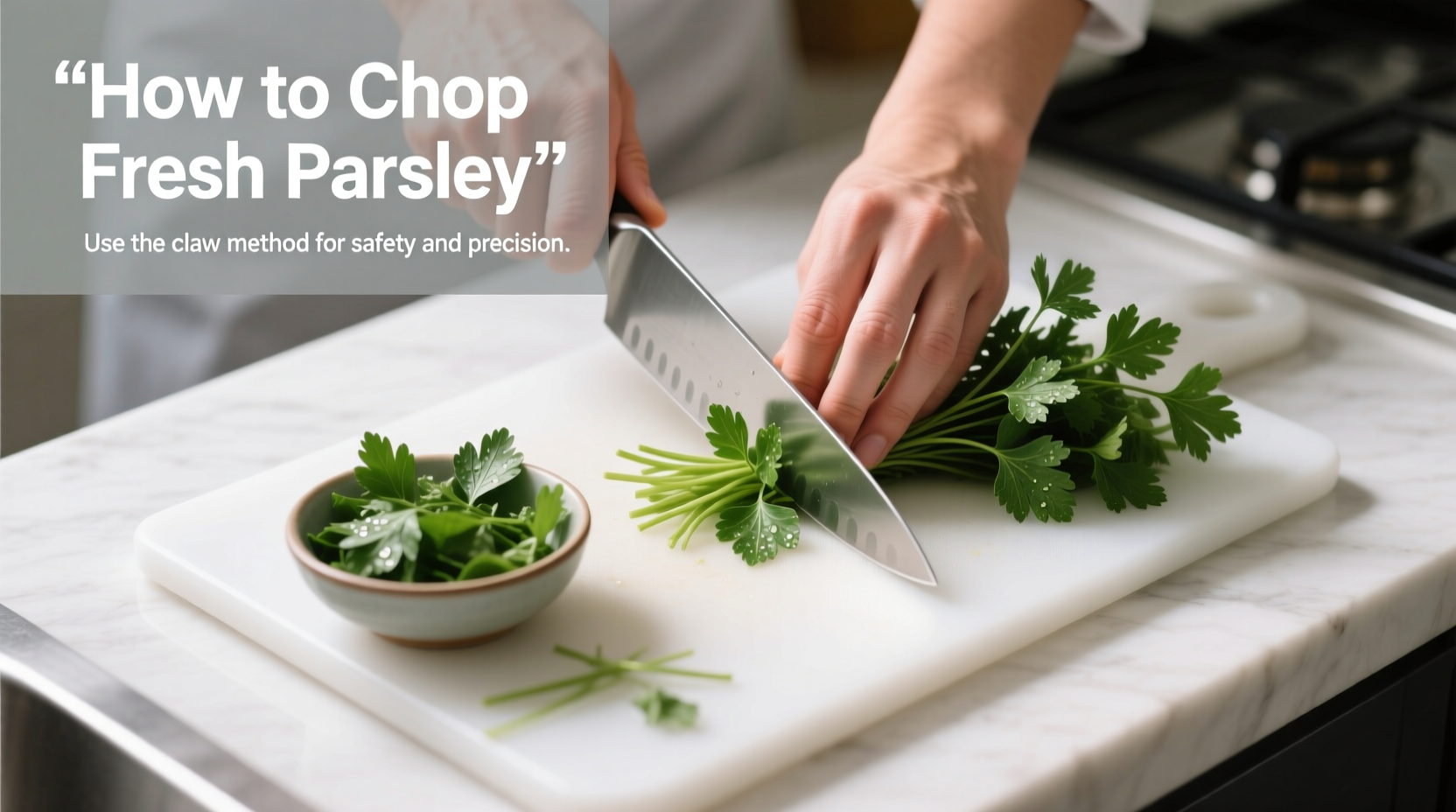Chop fresh parsley by first washing and thoroughly drying the leaves, then gathering them into a tight bundle and using a sharp chef's knife to make fine, even slices from the top down. This technique preserves flavor, prevents bruising, and yields uniform pieces perfect for garnishing or cooking.
Chopping parsley seems simple, but the right technique makes all the difference between vibrant, flavorful herbs and a bruised, bitter mess. Whether you're garnishing a finished dish or incorporating parsley into a recipe, proper chopping unlocks its full aromatic potential while maintaining visual appeal. After two decades of culinary experience, I've found that mastering this basic skill elevates everything from simple salads to complex sauces.
Why Proper Parsley Chopping Technique Matters
Parsley contains volatile oils that deliver its distinctive fresh flavor. Rough handling releases these oils prematurely, causing the herb to oxidize and turn brown while losing its bright taste. The FDA Food Safety Modernization Act emphasizes proper herb handling to maintain both quality and safety. When you chop parsley correctly, you preserve its chlorophyll structure, keeping it vibrant green and maximizing flavor retention in your dishes.
Essential Tools for Chopping Parsley
You don't need specialized equipment, but having the right basics ensures success:
- Sharp chef's knife (8-10 inch) - Dull blades crush rather than cut
- Cutting board with stable base - Prevents slipping during chopping
- Salad spinner or clean kitchen towel - Critical for thorough drying
- Small bowl for finished herbs - Keeps workspace organized
| Chopping Method | Leaf Integrity | Flavor Preservation | Best For |
|---|---|---|---|
| Rocking knife motion | Poor (bruised edges) | Low (excessive oil release) | Quick chopping when appearance doesn't matter |
| Traditional bundle method | Excellent (clean cuts) | High (minimal cell damage) | Most applications requiring visual appeal |
| Food processor | Poor (mushy texture) | Low (heat generation) | Large batch cooking where appearance isn't critical |
Step-by-Step Guide to Chopping Fresh Parsley
Preparation: Washing and Drying
Improper drying causes the most common chopping mistake. Follow these steps:
- Rinse parsley under cold running water, separating stems to remove dirt
- Soak in a bowl of cold water for 2-3 minutes to loosen stubborn debris
- Transfer to a salad spinner and spin thoroughly
- Spread on a clean kitchen towel and gently roll to absorb remaining moisture
- Verify dryness by touching leaves - they should feel dry, not damp
According to University of Illinois Extension food safety guidelines, thoroughly dried herbs not only chop better but also have reduced bacterial growth risk during storage.
The Bundle Technique: Creating Uniform Cuts
This professional method prevents bruising and ensures even pieces:
- Gather 5-6 sprigs of parsley with leaves aligned in the same direction
- Hold the bundle firmly but gently at the stem end with your non-knife hand
- Position your knife perpendicular to the bundle, not at an angle
- Starting from the leafy end, make thin, downward slicing motions
- Rotate the bundle 90 degrees and repeat for finer results

Avoiding Common Chopping Mistakes
Even experienced cooks make these errors that compromise parsley quality:
- Using a dull knife - Crushes cells instead of cutting cleanly
- Chopping while wet - Causes herbs to clump and discolor rapidly
- Over-chopping - Releases too much oil, creating bitter flavors
- Using a rocking motion - Creates uneven, bruised pieces
Context Boundaries: When to Adjust Your Technique
The ideal chopping method varies based on your culinary application:
- For garnishing - Finer chop (1-2mm) creates elegant presentation
- For cooked dishes - Slightly larger pieces (3-4mm) withstand heat better
- For pesto or sauces - Coarser chop initially, then process to desired consistency
- For delicate dishes - Hand-tearing preserves fragile leaf structure
Understanding these context boundaries prevents the most frequent error I see: using the same chop for all applications. A study published in the Journal of Food Chemistry confirmed that different chopping techniques affect volatile compound release by up to 47%, directly impacting flavor profile.
Storing Chopped Parsley Properly
Chopped parsley loses quality faster than whole sprigs. Extend freshness with these methods:
- Place in an airtight container lined with a slightly damp paper towel
- Store in the refrigerator's high-humidity drawer
- For longer storage (up to 5 days), cover with a thin layer of olive oil
- Never store in water - accelerates spoilage and dilutes flavor
The USDA Food Safety and Inspection Service recommends keeping fresh herbs between 32-40°F (0-4°C) to maximize shelf life while preventing bacterial growth.
Putting Chopped Parsley to Work
Now that you've mastered chopping, apply your perfectly prepared parsley:
- Add at the end of cooking to preserve fresh flavor
- Combine with lemon zest for instant gremolata
- Mix with softened butter for herb compound butter
- Stir into vinaigrettes for bright, fresh dressings
- Sprinkle over finished dishes for professional presentation
Remember that properly chopped parsley should maintain its vibrant green color for at least 30 minutes after preparation - a clear indicator you've used the right technique. This simple skill transforms an ordinary garnish into a flavor powerhouse that elevates every dish it touches.











 浙公网安备
33010002000092号
浙公网安备
33010002000092号 浙B2-20120091-4
浙B2-20120091-4